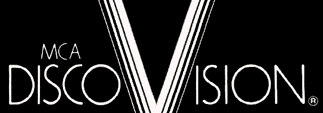
Radio-Electronics
April 1979
Videodisc!
by Larry Steckler
|
Here's an introductory look at how they work and compare. It has been a long time coming, but the fabled videodisc is finally here. The very first players using the Philips optical system, complete with built-in laser for scanning the disc, went on sale in Atlanta, Georgia on December 15, 1978. That handful of equipment sold out, at $695 each, that very same day. In February 1979 another group of videodisc players were offered for sale in Seattle, Washington - it was another sellout.  The players have been introduced by Magnavox Consumer Electronics, the United States subsidiary of the North American Philips Company. The optical videodisc system was developed by Philips and is being marketed under the trade name of Magnavision. Program material for the new players is also ready now. MCA has a catalog of more than 200 discs including everything from cooking lessons, to sports events, to recent full-length movies. A half-hour disc costs about $5.95 and a two-hour motion picture about $15.95. The players have been introduced by Magnavox Consumer Electronics, the United States subsidiary of the North American Philips Company. The optical videodisc system was developed by Philips and is being marketed under the trade name of Magnavision. Program material for the new players is also ready now. MCA has a catalog of more than 200 discs including everything from cooking lessons, to sports events, to recent full-length movies. A half-hour disc costs about $5.95 and a two-hour motion picture about $15.95.
A competitive system (no equipment is yet available for sale) has been announced by RCA. This system is a capacitive disc - is not compatible with the Philips system - and the discs cannot be interchanged. There are already indications that some other manufacturers may adopt the RCA system. So far it looks like Panasonic and JVC have joined with RCA and their system. However, since the Magnavision system is already available we will talk about it first. Let's start by answering the question: What is a videodisc? For the Philips system it is simply a pre-recorded disc that looks very much like a long-playing phonograph record that delivers visual and audio signals to a standard television set. It can be replayed again and again without wear or deterioration. Some discs play up to two hours of color - or black and white - programming with stereo sound. Others can be played frame by frame for still presentation or stop action. There are two playback modes. When the Magnavision player is operating in the standard play mode, the videodisc rotates ta 1800rpm and provides one separate image on each revolution. A disc can be played normally at 30 frames per second or in slow motion, backwards or freeze-frame mode. All frames are individually coded with index numbers and can be selected quickly by the player's random-access feature. In the Magnavision system there are two modes for playing videodiscs. In the extended-play mode, the videodisc will play up to 60 minutes per side for a total of two hours. In the standard-play mode, the disc will play up to 30 minutes per side for a total playing time of 60 minutes. To play the Magnavision videodisc, a compact video player is used. It is about the size of a phonograph turntable and is attached to the television set through its antenna system. Pictures appear on the television screen with a quality claimed to be better than even a cable hook-up can provide. My viewing time was limited, so I can only say the pictures that I watched were clean, clear and bright - at least equal to the very best broadcast TV. As the audio quality of the disc is much better than the audio system in the average TV set, sound fidelity can be improved by hooking up the players audio to the owner's stereo system. A laser beam is used to scan the videodisc. As a result no stylus ever touches the disc and repeated handling or use cannot wear out or diminish videodisc quality. A thin plastic coating on the surface of the disc protects the program from fingerprints, dust or surface scratches. 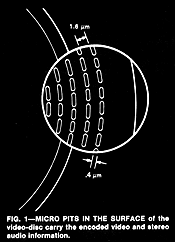 Every Magnavision videodisc is composed of thousands of circular tracks that form a continuous spiral from the inside of the videodisc to the outside. These tracks are analogous to grooves in an ordinary audio record. However, these tracks are not "grooves." Instead they consist of microscopic pits that are actually minute indentations in the videodisc material. You can see an enlarged view of this in Figure 1. Note that this diagram shows the width of a single track as well as the track pitch or space between tracks. The dimensions are given in microns. (A micron is one millionth of a meter.) The length of the pits and the spacing between them determines the intelligence on the videodisc. Every Magnavision videodisc is composed of thousands of circular tracks that form a continuous spiral from the inside of the videodisc to the outside. These tracks are analogous to grooves in an ordinary audio record. However, these tracks are not "grooves." Instead they consist of microscopic pits that are actually minute indentations in the videodisc material. You can see an enlarged view of this in Figure 1. Note that this diagram shows the width of a single track as well as the track pitch or space between tracks. The dimensions are given in microns. (A micron is one millionth of a meter.) The length of the pits and the spacing between them determines the intelligence on the videodisc.
The information encoded on the optical videodisc is the resultant of three FM signals. These signals are 8.1mHz FM modulated with composite video (including Chroma); 2.3mHz FM modulated with channel 1 sound; and 2.8mHz FM modulated with channel 2 sound. Each of the sound carriers has a maximum deviation of 100kHz. The bandpass of the 8.1mHz video carrier extends from below 4mHz to above 12mHz so that all necessary side bands can be included. Each of the sound FM signals pulse width modulates the 8.1mHz video FM to create the actual resultant signals that is encoded on the videodisc. The Optical System 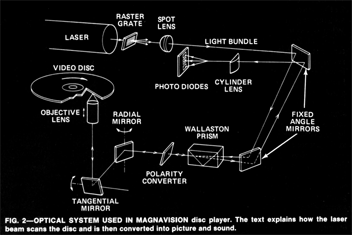 The heart of the Magnavision player is the laser and optical components. Figure 2 shows the path traveled by the laser light beam. The first optical element is the RASTER GRATE. This device is a piece of glass with several fine horizontal lines etched in it. It divides the main beam into three beams - one above and one below the main beam. The secondary beams are slightly smaller and dimmer than the main beam. (Actually, the RASTER GRATE creates more than three beams, but the others are so dim that they can be ignored.) The heart of the Magnavision player is the laser and optical components. Figure 2 shows the path traveled by the laser light beam. The first optical element is the RASTER GRATE. This device is a piece of glass with several fine horizontal lines etched in it. It divides the main beam into three beams - one above and one below the main beam. The secondary beams are slightly smaller and dimmer than the main beam. (Actually, the RASTER GRATE creates more than three beams, but the others are so dim that they can be ignored.)
The center beam is used to read the tracks on the disc, while the two adjacent beams are used for radial tracking. The next element is the SPOT LENS. It focuses the beam to the correct size so that the beam spot on the disc will be the correct size. The FIXED ANGLE MIRRORS merely fold the beam around so the optics of the player can be kept compact. The WOLLASTON PRISM is the next optical component in the light path. This type of prism has a special characteristic - it is designed to bend light in a direction determined by the polarity of the light beam passing through it. Thus, vertically polarized light is bent in the opposite direction of horizontally polarized light. This characteristic is important when separating the reflected beam from the transmitter beam. As the beam leaves the left end of the prism it passes through the POLARITY CONVERTER. the main purpose of this device is to change the vertically polarized beam into a circularly polarized beam. It now reflects off the RADIAL and TANGENTIAL MIRRORS into the OBJECTIVE LENS. This lens is similar to a microscope and focuses the beam into a tiny spot on the surface of videodisc pits. Now the beam reflects off the surface of the pits. At this point it becomes intensity modulated because the light reflected from inside a pit is less bright than light reflected from the surface between the pits. This action occurs because the pits have a depth equal to ¼ the wavelength (90°) of the red laser light. Since the light wave takes ¼ of the wavelength going into the pit and another ¼ wavelength coming out, it is ½ wavelength (180°) out of phase with the light at the surface of the pits. A cancellation effect takes place that reduces the intensity of the beam as it passes through. The reflected beam f9ollows the identical path, except in reverse, all the way back to the Wollaston prism. However, on this return trip the light wave is circularly polarized oppositely from what it was because the beam is traveling in the opposite direction. As a result, the beam is changed to horizontally polarized light as it passes back through the polarity converter. Thus, vertically polarized light comes out of the left end of the WOLLASTON PRISM, but horizontally polarized light goes into the left end of the Wollaston prism. As a result of this polarity differences, the prism bends the reflected beam downward as it exits the right end of the prism. The incident beam and the reflected beam are now separated. The reflected beam angles around the fixed angle mirrors, passes through the cylinder lens and lands on the photo diodes. Remember that the light bundle landing on the diodes actually contains three beams. These beams landing on the diodes generate the FM signal, the focus error voltage and the radial tracking error voltage. The FM signal is now fed to circuitry that translates it back into a video signal with two channels of audio. The focus error and radial tracking error signals keep the beam in the proper groove. A much more complete article will appear next month going into a more comprehensive description of how these signals are used to produce slow-motion and stop-frame action. In addition we will look at some of the actual circuitry involved. RCA's Capacitive Disc 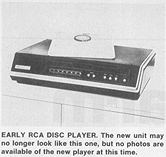 In a completely different way, RCA has put together its videodisc. Picture quality, as judged in a limited viewing test looks just as good as the Magnavision system. At some later date, when I've had the opportunity to have spent a lot more time watching and comparing quality in an "at home" atmosphere I'll pass along some comparative comments. But for now, the picture quality of the two systems is about the same. In a completely different way, RCA has put together its videodisc. Picture quality, as judged in a limited viewing test looks just as good as the Magnavision system. At some later date, when I've had the opportunity to have spent a lot more time watching and comparing quality in an "at home" atmosphere I'll pass along some comparative comments. But for now, the picture quality of the two systems is about the same.
The RCA videodisc can store two hours of recorded picture and stereo sound on a disc - one hour on each side of the 12-inch disc. A spiral "V"-shaped groove guides the diamond pickup stylus as the disc rotates at 450 rpm. Figure 3 shows the grooved surface of the disc and the top of the stylus tracking in the groove. Information representing the luminance, chroma and audio signals is contained in transverse slots of varying width and periodicity impressed into the bottom of the groove. The tip of a thin metallic electrode on the flat trailing edge of the stylus serves as a capacitance prove for the recovery of the signal. The conductive surface of the disc serves as the other plate of the "capacitor". As the disc rotates and the stylus tracks along the groove, the capacitance variations caused by the passing of the signal-bearing indentations under the stylus tip are sensed. These signals are converted to video and audio information and the unit plays back through a conventional TV set. The capacitive pickup does require the use of a conductive disc. In an earlier version this was done by applying a conductive coating over the surface of the disc. In the latest version a conductive plastic is used in the manufacture of the disc and the coating is no longer needed. A buried subcarrier encoding system is used to take bet advantage of the capacitance pickup in terms of picture quality and disc playing time. It is based on the use of an FM carrier for the video information and separate FM carriers for the audio information in a single track. The buried subcarrier encoding allows the color signal to be handled in the same channel as the luminance, produces a very high quality color picture, and allows a low video carrier frequency. A direct benefit of the low carrier frequency is the long playing time, since the limitation is usually the shortest reproducible wavelength. The Stylus 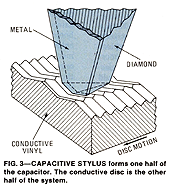 Since the RCA disc is a grooved disc, it is vital that the stylus track properly in the groove. The basic tracking problem in the RCA videodisc is quite similar to that encountered in audio players. The tracking forces are applied vertically, primarily by the spring metal flylead that connects to the tip of the stylus support arm. Since the RCA disc is a grooved disc, it is vital that the stylus track properly in the groove. The basic tracking problem in the RCA videodisc is quite similar to that encountered in audio players. The tracking forces are applied vertically, primarily by the spring metal flylead that connects to the tip of the stylus support arm.
Also, since there is a groove and a stylus the life of the stylus is important. Figure 4 shows the stylus used. Note the keel-shaped protrusion on the bottom of the V. Since the keel has relatively straight sides, its width will not increase as it wears. Therefore, its initial width can be made almost equal to that of the signal elements of the groove. With this kind of geometry, life is primarily a function of how high the keel can be made before it becomes fragile. 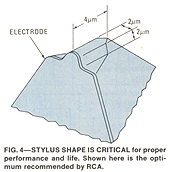 The length of the keel is also important. Here the limitation is the lift-off of the electrode when playing a warped disc as the shoe becomes too long. Many experiments have show that the dimension shown in Figure 4 is optimum. The length of the keel is also important. Here the limitation is the lift-off of the electrode when playing a warped disc as the shoe becomes too long. Many experiments have show that the dimension shown in Figure 4 is optimum.
The remaining key dimension is the "prow" angle. This is the angle that the leading edge of the stylus makes with the disc. If the angle is too steep the tip may become fragile. In addition, while some fine debris is pushed out of the way, some tends to wrap around the top lifting it out of the groove. If the angle is too shallow, the tip becomes stronger and critical wrap-around is reduced. But the tip will not push as much debris out of the way and will tend to lift to ride over it causing loss of signal pickup. RCA has found that an angle of about 30° is a good compromise. One of the problems in any videodisc is that since the rpm is consistent, the performance at the inside of the disc is inferior to performance at the outside of the disc. However, the RCA system has been designed to give high quality even at the inner radius, which is reached only after 60 minutes of playing time. This means, of course, that the performance of most of the disc is better than the designated minimum. Where do we go from here. Naturally, the real test of the videodisc is in the marketplace. The RCA system, which is expected to sell for $495 is $000 less expensive than the Magnavision system. Bit it may not be able to provide slow motion or stop motion. The real question is whether a customer will pay $200 more for slow and stop motion. And this depends upon how the user intends to use his player. If he is going to watch motion pictures or his favorite singing star or his favorite jazz bad, stop motion doesn't have very much value. But if the consumer intends to learn to tie fishing flies, or to cook quiche, the frame by frame viewing becomes vital. It's even more important for a picture by picture tour of an art museum. Both the optical and the capacitance systems appear to be functional, reliable and workable. It is my personal feeling that the availability of software, records to put on the player, will be a more important consideration to the consumer than the type of system. Videodisc or videotape Both videodisc and videotape have a place in the consumer market just as audio tape and audio discs coexist. If a user has no need to record, he doesn't need the added cost of a recorder. Just the same, there are bound to be many users who will have both disc and tape systems and use each one as it is best suited. When we couple videodisc and videotape and large screen projection TV, we come up with an entertainment medium that bears only a faint resemblance to the early TV's. The new sets are coming close to matching the dreams of those early experimenters, but it's still a way to flat screens and 3-D pictures. |